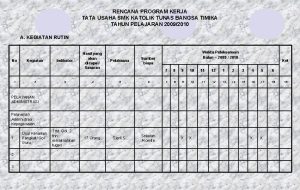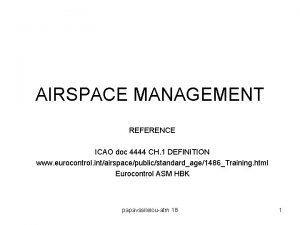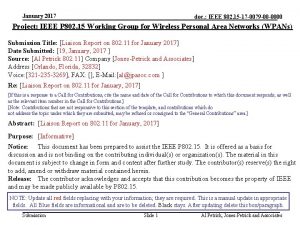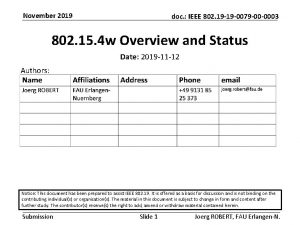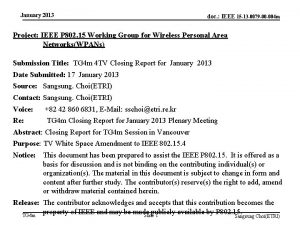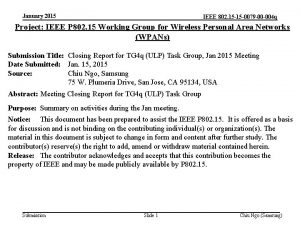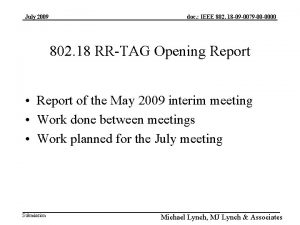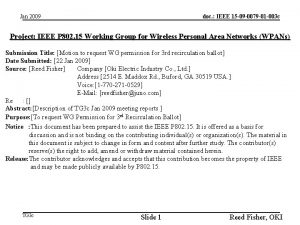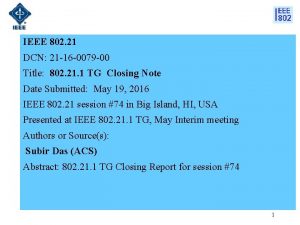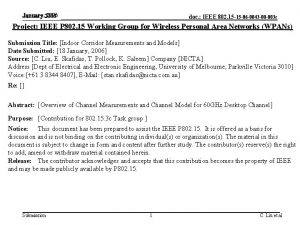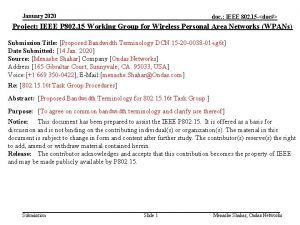January 2019 doc IEEE 802 11 19 0079













- Slides: 13

January 2019 doc. : IEEE 802. 11 -19 -0079 r 0 Considerations for Backward Compatibility Date: 2019 -01 -08 Authors: Submission Slide 1 Fischer - Filippi - Martinez, NXP

January 2019 doc. : IEEE 802. 11 -19 -0079 r 0 Abstract • This submission provides a summary of critical items that Task Group bd must consider in order to provide a smooth transition from 802. 11 p to the new technology introduced for future vehicular applications. • We elaborate on the need for interoperability and coexistence at both the system and the protocol level, backward compatibility with legacy IEEE 802. 11 p stations, and fairness of channel access among all stations. • We consider it critical for 802. 11 bd to be designed for efficient operation during the period when large amounts of 802. 11 p equipment is in use, not just in the future when nearly all deployed equipment supports NGV. Submission Slide 2 Fischer - Filippi - Martinez, NXP

January 2019 doc. : IEEE 802. 11 -19 -0079 r 0 Introduction • By the time 802. 11 bd is standardized and deployed, there will be millions of vehicles, and (at least) tens of thousands of RSUs, in service using 802. 11 p • Several automobile manufacturers are already beginning their 802. 11 p roll-out • Over 5300 RSUs have already been installed in the USA (source: Car 2 Car Consortium), also significant numbers in parts of Europe, such as Germany and Austria • The EU recently published its ITS-G 5 Delegated Act Directive, ensuring that 802. 11 p-based equipment will be deployed in Europe for many years to come • Task Group bd needs to define a protocol that provides benefits in an environment with a mixture of 802. 11 p and 802. 11 bd equipment • If NGV enhancements are only available in the absence of 802. 11 p equipment, the benefits of NGV are deferred so far into the future that NGV is unlikely to ever be deployed • The task group should adopt techniques that are adaptive and cooperative, rather than a modal approach that cannot deliver the new functionality when 802. 11 p stations are present Submission Slide 3 Fischer - Filippi - Martinez, NXP

January 2019 doc. : IEEE 802. 11 -19 -0079 r 0 Difference between IEEE 802. 11 p/bd & ITS-G 5 / SAE (1) Facilities Network & Transport Access technology Submission RHS/CAA TS 102 539 -1 ICRW TS 102 539 -2 LCRW TS 102 539 -3 CAM EN 302 637 -2 DENM EN 302 637 -3 LDM TS 102 724 Geo. Networking EN BTP 302 636 -4 -1/2 EN 302 636 -5 -1 DCC - TS 103 141 TS 103 097/102 94 x Security Example: ITS-G 5 stack overview TS 102 723 -x Cross-Layer Ifx Applications TS 102 894 -2 Common Data Directory • IEEE 802. 11 p is used as the access layer of several V 2 X regional standards such as ITS-G 5 in Europe or SAE in the US. IEEE 802. 11 bd needs to be an enhancement to this access layer. • On top of the IEEE 802. 11 -based access layer, regional standards define a set of rules for decentralized congestion control (DCC), packet generation and dissemination ITS-G 5 Access Layer EN 302 663 / IEEE 802. 11 p Slide 4 Fischer - Filippi - Martinez, NXP

January 2019 doc. : IEEE 802. 11 -19 -0079 r 0 Difference between IEEE 802. 11 p/bd & ITS-G 5 / SAE (2) • TGbd exists to standardize the PHY and MAC layers, collectively referred to as the “access layer”, as an enhancement to IEEE 802. 11 p. • The regional regulators will continue to specify the rules for DCC, packet generation and dissemination, security, etc. • There is no reason for TGbd to include functions that are assigned to other ITS layers • 802. 11 bd needs to be a standard with a number of parameters and encoding options, providing a toolbox that can support a wide range of regional deployment configurations. • For instance ITS-G 5 requires IEEE 802. 11 p PPDUs to be encoded with QPSK ½ (6 Mb/s transmit rate), whereas SAE adjusts the MCS based on congestion level • For instance in ITS-G 5 the CAM message generation is triggered by the vehicle dynamics (“enough” change in location, headings or speed) while SAE transmissions have often a more periodic nature (often transmitted at 10 Hz) Submission Slide 5 Fischer - Filippi - Martinez, NXP

January 2019 doc. : IEEE 802. 11 -19 -0079 r 0 Status on the frequency channels usage (1) • ITS spectrum is limited, and already partly in use in different regions for various applications (urban-rail, road-tolling, platooning, smart tacograph, V 2 X safety applications…) • IEEE 802. 11 bd will be deployed (at least in part) using channels that are already used for IEEE 802. 11 p • The possibility of IEEE 802. 11 bd being able to use in a brand new and empty channel is certainly desirable from an engineering perspective, but unlikely Submission Slide 6 Fischer - Filippi - Martinez, NXP

January 2019 doc. : IEEE 802. 11 -19 -0079 r 0 Status on the frequency channels usage (2) Coexistence and Cooperation between IEEE 802. 11 p and IEEE 802. 11 bd stations in the same channel is required. Coexistence: “Situation in which one radio system operates in an environment where another radio system having potentially different characteristics (e. g. RAT) may be using the same or different channels, and both radio systems are able to operate with some tolerable impact to each other. ” (Source: EN 303 145 V 1. 2. 1) Cooperation (also called Interoperability): “Situation in which one radio system operates in an environment where another radio system having potentially different characteristics (e. g. RAT) may be using the same or different channels, and both radio systems are able to send information that can be successfully decoded by the counterpart radio system. ” (Source: NXP) Submission Slide 7 Fischer - Filippi - Martinez, NXP

January 2019 doc. : IEEE 802. 11 -19 -0079 r 0 Interoperability at system and protocol level While NGV is likely to support new features and additional services, it is mandatory that NGV continue to satisfy all the current V 2 X use cases. Interoperability at system and protocol level with deployed IEEE 802. 11 p stations is critical. Day 1* Services Day 1. 5* Services Num. Day 1 Services Type Domain Num. Day 1. 5 Services Type Domain 1 Emergency electronic brake light V 2 V Safety 1 Off street parking information V 2 I Parking 2 Emergency vehicle approaching V 2 V Safety 2 On street parking information and management V 2 I Parking 3 Slow or stationary vehicle(s) V 2 V Safety 3 Park & Ride information V 2 I Parking 4 Traffic jam ahead warning V 2 V Safety 4 Information on AFV fuelling & charging stations V 2 I Smart Routing 5 Hazardous location notification V 2 I Motorway 5 Traffic information and smart routing V 2 I Smart Routing 6 Road works warning V 2 I Motorway 6 Zone access control for urban areas V 2 I Smart Routing 7 Weather conditions V 2 I Motorway 7 Loading zone management V 2 I Freight 8 In-vehicle signage V 2 I Motorway 8 VRU protection (pedestrians and cyclists) V 2 X VRU 9 In-vehicle speed limits V 2 I 9 Cooperative collision risk warning V 2 V 10 Probe vehicle data V 2 I Motorway 10 Motorcycle approaching indication V 2 V Collision 11 Wrong way driving V 2 I Wrong Way 11 Shockwave damping V 2 I Motorway 12 GLOSA / Time To Green (TTG) V 2 I Urban 13 Signal violation/Intersection safety V 2 I Urban 14 Traffic signal priority request (designated veh. ) V 2 I Urban Submission (*): as per EU commission report https: //ec. europa. eu/transport/sites/transport/files/themes/its/doc/c-its-platform-final-reportjanuary-2016. pdf Slide 8 Fischer-Filippi-Martinez - Filippi - Martinez, (NXP) NXP

January 2019 doc. : IEEE 802. 11 -19 -0079 r 0 Backwards compatibility to IEEE 802. 11 p standard • To guarantee that the NGV and IEEE 802. 11 p stations can interact, exchange data, and collaborate towards the common goal of a cooperative intelligent transport system, it is essential that the NGV stations add value to the overall network, in particular from the perspective of “legacy” IEEE 802. 11 p stations. • NGV PPDUs must be detectable and decodable whenever and wherever NGV stations operate in an environment with collocated 802. 11 p stations. • Therefore the NGV PPDU format should adaptable, and at least be partly encoded as defined by IEEE 802. 11 p, wherever and whenever backward compatible operation is necessary. Submission Slide 9 Fischer - Filippi - Martinez, NXP

January 2019 doc. : IEEE 802. 11 -19 -0079 r 0 NGV performance improvement Advanced encoding and modulation techniques have been successfully standardized and deployed in IEEE 802. 11 n and IEEE 802. 11 ac. NGV can certainly benefit from some of these improved techniques, including, but not limited to LDPC, STBC, MIMO, etc. It is also possible to improve the reliability and performance of communication using the 802. 11 p waveform, as previously presented to the NGV SG (see document 11 -18/1577 r 0): ü Transmitter RF improvements: - Tighter Spectrum Emission Mask (SEM) to reduce out-of-channel emissions for better MCO ü Receiver performance improvements - Minimum sensitivity in static channels should be increased by about 6 d. B NGV should add various multipath fading sensitivity requirements for reliable mobility support ü Adaptive repetition of messages Submission IEEE 802. 11 p stations see each retransmission as a standalone message. Boost by 0. 5 -1. 7 d. B NGV stations can combine the initial PPDU and retransmissions - +4 d. B performance boost for 1 retransmission - +7 d. B performance boost for 3 retransmissions Slide 10 Fischer - Filippi - Martinez, NXP

January 2019 doc. : IEEE 802. 11 -19 -0079 r 0 Fairness in channel access • ITS is fundamentally a cooperative system where benefits accrue from collaborative information exchange. • We must ensure that all the ITS stations participating in a V 2 X communication network will have fair access to the medium, competing for channel access according to the same rules. • For example, for ITS-G 5 in Europe, the CSMA/CA channel access in NGV must be able to be configured equivalently to IEEE 802. 11 p, as shown below: Submission AC CWmin CWmaw AIFS AC_VO 3 7 AC_VI 7 15 58 µs 71 µs AC_BE 15 1023 110 µs AC_BK 15 1023 149 µs Slide 11 Fischer - Filippi - Martinez, NXP

January 2019 doc. : IEEE 802. 11 -19 -0079 r 0 Smooth transition from 802. 11 p to 802. 11 bd (1) To achieve a smooth transition from 802. 11 p to 802. 11 bd, the NGV stations must adapt to their current operational environment, which will evolve over time. 100% Percentage of messages sent on the channel NGV Some legacy stations might have a long lifetime (ex: infrastructure traffic light etc. ) in certain environments (some cities, but not all). 50% Legacy 802. 11 p 0% time … Phase 1 NGV roll-out start Submission … … Phase 2 NGV develops Slide 12 … Phase 3 Legacy stations phase-out Fischer - Filippi - Martinez, NXP

January 2019 doc. : IEEE 802. 11 -19 -0079 r 0 Smooth transition from 802. 11 p to 802. 11 bd (2) Phase Title Description NGV stations objectives Phase 1 NGV roll-out starting Few NGV stations. Most stations are legacy 802. 11 p • • Phase 2 NGV develops Transition phase. Both technologies are present in the channel in nonnegligible amount • • Phase 3 Legacy stations phase-out Legacy stations are out-numbered by NGV & are being retired from system • NGV stations should have zero impact on performance of legacy 802. 11 p stations NGV should add value to the overall ITS system NGV stations can start to deliver enhanced capabilities, with light impact on performance of legacy 802. 11 p stations NGV should add value to the overall ITS system NGV stations can unleash their full benefits, while maintaining backwards compatibility in environments where legacy stations are still around For all phases, NGV must provide fair access to the channel: - NGV messages should have approximately the same air-time than legacy 802. 11 p messages sent in the similar conditions - The same rule for access to the channel (ex: CSMA/CA) should apply to both legacy and NGV stations Submission Slide 13 Fischer - Filippi - Martinez, NXP












